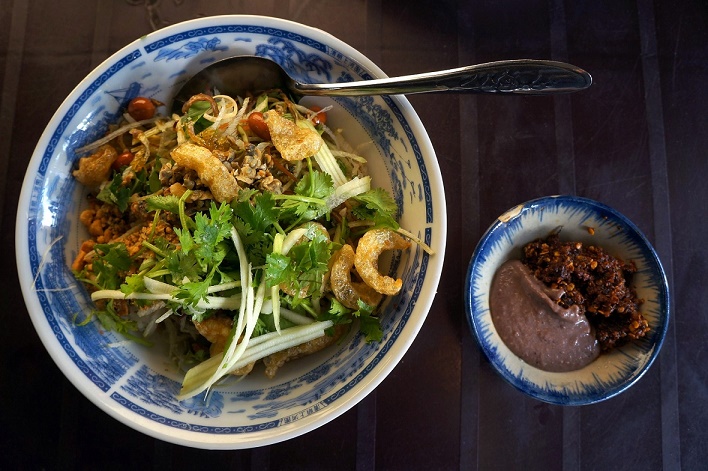
Many people ask me what makes Huế cuisine different from the food in other areas of Vietnam whenever I tell them I love Huế food. Well, it isn’t easy to give them a correct answer, is it? However, in my opinion, apart from its elegant presentation and fresh ingredients, Huế food is amplified by the addition of ‘ruốc’ and ‘ớt’ (red hot chili – either fresh or dry powder). Those two seasonings are like the ‘soul’ of Huế culinary style.
‘Ruốc’ is a kind of fermented tiny shrimp paste. It’s salty and very smelly. It can be found in ‘canh’ (soups) or ‘bún bò Huế’ (Huế beef noodles). I sometimes sneak into my mother’s kingdom, I mean her kitchen, to cook us my favorite vegetable ‘canh’. Of course, most of the time, my mother is happy to let me in but never does she forget to remind me to add some ‘ruốc’ in our ‘canh rau’ (vegetable soup) before leaving that kingdom to me for a while. I feel that unlike salt which is quite bitterly salty, ‘ruốc’ is salty but has a slight of succulence in it. It doesn’t seem like Huế people like adding sugar in their ‘canh’ so ‘ruốc’ obviously becomes one of the indispensable seasonings in Huế kitchens. Besides, you can turn ‘ruốc’ into a tasty dipping sauce for steamed vegetables by mixing it with water and simmering it in red-onion-fried oil. In the old hungry days when my mother and I found it hard to make two ends meet, my mother would make this dipping sauce from ‘ruốc’ to eat with steamed wild vegetables she would pick in the fields or on the riverbanks. ‘Ruốc’ can be simply prepared by adding in chopped red chilli and garlic with lime juice and a pinch of sugar. This thick dipping sauce can go well with fresh vegetables such as cucumber, vả (a kind of fig), and some other kinds of leaves found in Huế gardens. For those continually rainy days in Huế when we ran out of food except for rice and my mother didn’t have much money left to shop for us some meat or vegetables, we would mix a spoonful of ruốc with ground red chilli (sometimes we dropped in some hot oil) and eat with hot steamed rice. It still tasted heavenly good on those days, I can assure you.
And a dish won’t be considered Huế food unless it’s so spicy that it can burn your mouth. It’s not difficult to run into a diner completely enjoying her spicy food while its heat makes chains of sweat running on her face and her lips burning red. If you have ever had bún bò (beef noodles) in Huế, you will see a big steamy caldron filled with the stock which is covered with a thin layer of red-chili-fried oil. And you might also notice that on your table there are a little bowl of fish sauce with chopped red chili and another bowl of fried red chili paste waiting to be added in your ‘bún bò’. When I was a little girl, I always complained with tears in my eyes that our ‘canh’ – my favorite was too spicy and my mother’s forever and careless response was (and still is) that she only added a pinch of red hot chili powder in to make it look good and tasty. Of course, I didn’t believe her as the food was far beyond spicy. I’ve been growing with her spicy food and I don’t only get used to it but I think I have also been head over heels in love with it without knowing since when.
Now that you already know about the ‘soul’ of Huế food, you might wonder which Huế specialties have both of those mentioned seasonings that you should try when you have a chance to visit Huế. I’d happily recommend ‘bún bò’ and/or ‘cơm hến’ (clam rice).
Names of the dishes in the short video clip above:
– Ớt dầm nước mắm (Red hot chili in fish sauce)
– Tương ớt & Ruốc (Fried chili paste and Fermented tiny shrimp paste)
– Cơm hến (Clam rice)
– Bún bò (Huế beef noodles)
– Bánh canh (A kind of noodles)
– Ốc xào (Stir-fried snails)
– Cháo lòng (Porridge with pigs’ or cows’ intestines)